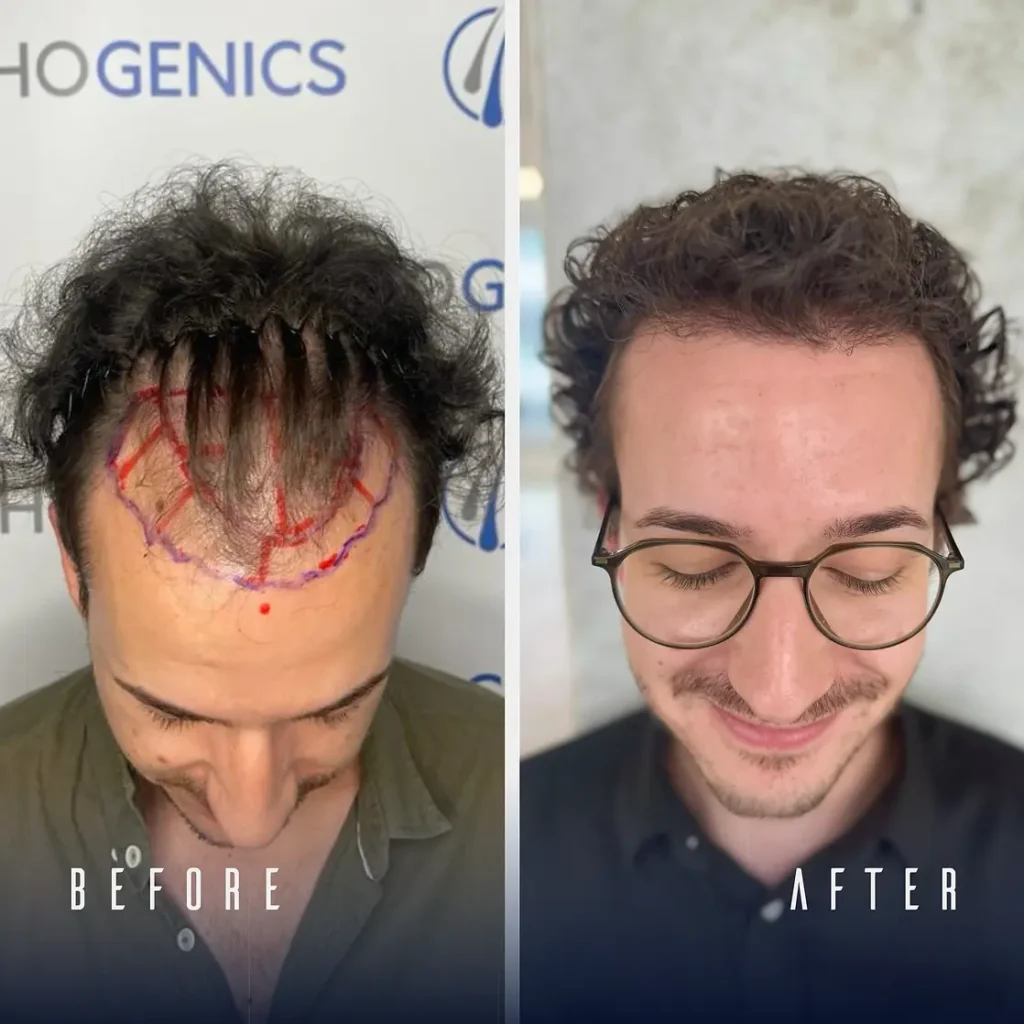At Trichogenics, founded by Dr. Asi and Dr. Eric Peretz, many patients want to know what happens four months after a hair transplant. This stage marks early visible changes and growing confidence.
At the hair transplant 4 months after stage, you can expect early but uneven hair growth as the follicles begin their active phase. The new strands may appear thin and patchy, which is completely normal at this point.
Most patients also experience mild shedding, known as shock loss, as weaker hairs fall out and make way for stronger ones. The donor area is usually healed, and density will continue to improve over the next several months.
This stage marks the visible start of recovery, where consistent care and patience lead to fuller, natural results.
Key Takeaways
- The hair transplant 4 months after the stage is when early regrowth begins, but visible density varies between patients depending on healing speed and the hair growth cycle.
- Mild shedding and side effects like shock loss are normal at this stage, as newly transplanted hair replaces weaker strands.
- Most patients see steady improvement in 4 month hair growth, though complete hair transplant results 4 months are still developing and continue to strengthen up to one year.
- Choosing a regulated clinic like Trichogenics in Greece or Israel ensures safer conditions, consistent follow-up, and better outcomes than risky, unregulated options in Turkey.
- Proper aftercare, medical supervision, and patience remain key to achieving lasting, natural hair regrowth and optimal final results.
Hair Growth and Appearance at 4 Months
What Should My Hair Transplant Look Like?
At four months, the transplanted areas start showing newly transplanted hair. You may see short, thin hairs appearing unevenly. The donor area usually looks healed and healthy by now.
This is the start of the hair growth cycle, when follicles move from the resting phase to the growth phase.
The new hair might look softer or lighter than your natural hair, but this will change with time. As the months go by, the hair becomes thicker and more uniform. Small gaps or uneven patches are normal at this stage.
Normal vs. Slow Growth Progress
Each patient heals differently. Some see clear progress at this stage, while others notice slow 4 month hair growth. Both are normal. Hair follicles grow in cycles, not all at once, which explains the difference.
If your hair transplant results in 4 months seem slow, don’t worry. The follicles are still settling and will keep growing stronger between months five and eight. The full hair transplant timeline takes up to a year for complete density and natural results.
No Results After 4 Months — Is It Normal?
Not seeing visible results after 4 months can be frustrating, but it doesn’t mean your hair transplant surgery failed. The scalp may still be in the resting phase of recovery. This is when follicles pause before producing new hairs.
At Trichogenics, patients receive follow-up care to check progress and support healthy regrowth. Dr. Asi Peretz reminds patients that patience is essential; the growth process continues even when results are not yet visible.
Shedding and Temporary Hair Loss
Is Shedding Normal at 4 Months?
Yes. Many patients experience mild hair shedding or shock loss during this time. It happens when weak strands fall out to make room for stronger newly transplanted hair. This is a normal part of recovery and shows that the follicles are active.
Your scalp should feel calm and show no major redness or pain. The donor area stays stable, and new hairs soon appear, replacing the ones that fell.
Managing Hair Loss After Surgery
To handle temporary shedding, care for your scalp gently. Use mild shampoos and avoid harsh rubbing or scratching. Keep the scalp clean and hydrated during this post-op stage.
At Trichogenics, doctors suggest simple lifestyle steps—eat well, stay hydrated, and avoid smoking or stress. These small habits improve blood flow and help the growth process.
@trichogenics What shampoo should you use after a hair transplant) Dr Eric Peretz explains. #hairtransplant #trichogenics #hairtransplantturkey #hairtransplantsurgery #hairtransplantgreece #hairtransplantshampoo #hairlosssolutions #hairloss #hairlossremedy #shampo #fyp
♬ original sound - Trichogenics
Recovery Timeline and Next Stages
Milestones From Month 1 to Month 4
Here’s what most patients experience during the first months post surgery:
- Month 1: The donor area heals, and scabs fall off.
- Month 2: The transplanted areas shed hair as follicles rest.
- Month 3: Thin hairs start growing again.
- Month 4: Hair becomes thicker and looks more natural.
This timeline can vary slightly, but gradual improvement shows your hair grows as expected.Learn more about recovery time at the following link.
What to Expect From Month 4 to 12
Between months five and twelve, changes become clearer. Hair grows faster, looks fuller, and feels stronger. By month six, most patients see real density.
Around month twelve, the fue hair transplant results look complete, blending with your existing hair.
Trichogenics monitors each step to make sure growth stays healthy and results remain consistent through the full hair transplant journey.
@trichogenics An incredible hair transformation for one of our favorite patients. #trichogenics #hairloss #hairtransplant #hairtransplantturkey #hairfall #hairfallsolution #hairtransplantgreece #hairtransplantresult #hairtransformation
♬ original sound - Trichogenics
Hair Care and Maintenance Tips
Safe Products and Daily Routine
Use gentle, sulfate-free shampoo. Wash the scalp with care and avoid tight hats or rough drying.
Light massages can help improve circulation and encourage growth. Protect the scalp from direct sun and extreme cold during the post-operation recovery process.
What to Avoid During Recovery
Avoid:
- Coloring or chemical treatments for six months.
- Heat, steam, or saunas.
- Excessive scratching or touching the scalp.
- Traveling to unregulated clinics, especially in Turkey.
Many low-cost clinics in Turkey perform procedures without medical oversight.
In contrast, Trichogenics, located in Greece and Israel, ensures all hair transplant procedures are done by licensed doctors, guaranteeing safe, hygienic, and lasting results.
Expert Insights from Trichogenics
Advice from Dr. Asi and Dr. Eric Peretz
Dr. Asi Peretz explains that the fourth month is when patients start noticing visible change. He says that comparing your results to others can be misleading because every scalp heals differently.
Dr. Eric Peretz highlights that clinics in regulated countries like Greece and Israel follow strict medical standards.
Trichogenics uses modern techniques and advanced tools to ensure precise graft placement and natural outcomes—unlike the unsafe, fast-track procedures offered in Turkey.
When to See Your Doctor
Warning Signs and Delayed Growth
You should contact your doctor if you notice:
- Ongoing redness or swelling after three weeks.
- Pain, discharge, or excessive hair shedding.
- No new growth by month six.
Trichogenics offers full medical follow-up and personalized care. The team tracks every patient’s recovery to make sure results stay on course and complications are addressed early.
Long-Term Expectations After a Hair Transplant
At four months after a hair transplant, progress might still look slow, but your follicles are working beneath the surface.
This stage marks the start of stronger, visible growth. With proper care and patience, your hair transplant results will continue to improve.

Choosing Trichogenics in Greece or Israel, led by Dr. Asi and Dr. Eric Peretz, ensures expert care, regulated safety, and reliable follow-up.
Avoid the risks of unregulated clinics in Turkey and trust a clinic that provides real medical standards and lasting results. Here, your natural hair can grow back safely and confidently.



